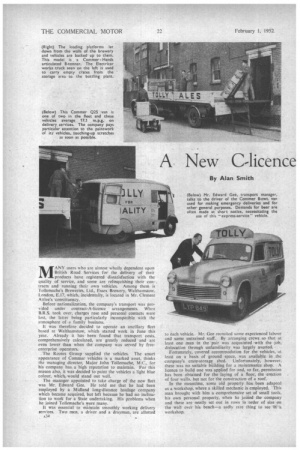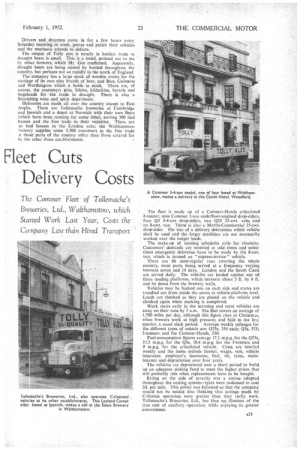New licence Fleet Cuts Delivery Costs
Page 56

Page 57

If you've noticed an error in this article please click here to report it so we can fix it.
The. Cottimer Fleet of Tollemache's Breweries, Ltd., Walthamstow, which Started Work Last Year, Costs the Company Less thcin Hired Transport By Alan Smith MANY users who are almost wholly dependent upon British Road Services for the delivery of their products have registered dissatisfaction with the quality of service, and some are relinquishing their con-. tracts and running their own vehicles. Among them is Tollemache's Breweries, Ltd., Essex Brewery, Walthamstow, London, E.17, which, incidentally, is located in Mr. Clement At tlee's constituency.
Before nationalization, the company's transport was provided under contract-A-licence arrangements. When B.R.S. took over, charges rose and personal contacts were lost, the latter being particularly incompatible with the atmosphere of .a family business.
it was therefore decided to operate an ancillary fleet based at Waltharnstow, which started work in June this year. Already it has been found that transport costs, comprehensively calculated, are greatly reduced and are even lower than when the company was served by freeenterprise operators.
The Routes Group supplied the vehicles. The smart appearance of Commer vehicles is a marked asset, thinks the managing director, Major John Tollemac-he, M.C., for his company has a high reputation to maintain. For this reason also, it was decided to paint the vehicles a light blue colour, whichwould stand out well.
. The manager appointed to take charge of the new fleet was Mr. Edward Gee. He told roe that he had been employed by a Midland long-distance haulage company which became acquired, but left because he had no inclination to work for a State undertaking. His problems when he joined Tollemache's ,vere many.
It was essential to maintain smoothly working delivery services. Two men, a driver and a drayman, are allotted A34 to each vehicle. Mr. Gee recruited some experienced labour and some untrained staff. By arranging crews so that at least one man in the pair was acquainted with the job,dislocation through unfamiliarity was largely averted.
Fortunately, covered accommodation for the vehicles, at least on a basis of ground space, was available in the company's crate-storage shed. Unfortunately, however, there was no suitable building for a maintenance shop. A licence to build one was applied for and, so far, permission has been obtained for the laying of a floor, the .erection of four walls, but not for the construction of a roof.
in the meantime, some old property has been adapted as a workshop, where a skilled mechanic is employed. This man brought with him a comprehensive set of small tools, his own personal property, when he joined the company and these are neatly set out in rows in order of size on the wall over his bench—a sadly rare thing to see itr-a workshop. Drivers and .draymen come in for a few hours every. Saturday morning to wash, 'grease and polish their vehicles and the mechanic attends to defects.
The output of Tolls/ ales is mostly in bottles: trade tn draught beers is small. This is a trend, pointed out to me by other brewers, which Mr. Gee confirmed. Apparently, draught beers are being ousted by bottled throughout the country, but perhaps not so rapidly in the north of England.
The-company has a large stock-of wooden crates for the carriage of its own nine brands of beer, and Bass, Guinness and Worthington which it holds in stock. There are, of cottrse, the custornary pins, firkins, kilderkins, barrels and hogsheads for the trade in draught: There is also a flourishing wine and spirit department.
Deliveries are made all over the country except to East Anglia. There are Tollemache breweries at Cambridge and Ipswich and a depot at Norwich with .their own fleets (which have been running .for.some" tithe), serving 300 tied houses and the free trade In: their vicinities. There are :to tied houses in the Londan areat• the Walthamstow brewery supplies some 3.500 customers in the free trade n those parts of the country other than those catered for by the other three establishments. The fleet is made up of .a Commer-Hands articulated 8-tortner, nine Commer 5-ton underfloor-engined' drop-,siders, four Q3 3-4-ton drop-siders, two Q25 25-cwt, vans and ' an 8-cwt. van. There is also a Mortis-Commercial 25-cwt. drop-sider. The size of a delivery determines which vehicle shalt be used and the larger.thachines are not necessarily
• worked over the longer leads. • The make-up of running schedules calls for elasticity. CuStomers' demands are 'received at odd times and sometimes emergency clelive'ries have to be made by the 8-cwt. van, which is termed an " express-service '' vehicle.
There are 86 semi-regular runs covering the whole country, most parts being served at a frequency varying between seven and 14 days. Landon and the South Coast are served daily. The vehicles are loaded against any .of three loading platforms, which measure about 5 ft. by 4 ft. and let down from the brewery walls.
Vehicles may be backed one on each side and crates are trundled out from inside the stores at Vehicle-platform level. Loads are checked as they are placed on the vehicle and • checked again when stacking is completed.
Work starts early in the morning and most vehicles are away on their runs by 7 a.m. The fleet covers an average of 1,700 miles per day, although this figure rises at Christmas, when brewers work at high pressure, and falls in the first quarter, a usual slack period. Average weekly mileages for the different types of vehicle are; Q25s, 350 each; Q3s, 575; 5-tonners and the Commer-liands, 550.
. Fuel-consumption figures average 17.1 m.p.g. for the Q25s, 11.5 m.p.g. for the Q3s, 10.4 m.p.g. for the 5-tormers and 9 m.p.g. for the articulated vehicle. Casts are totalled weekly and the items include licence, wages, rent, vehicle insurance, employer's insurance, fuel, oil, tyres, maintenance and depreciation over four years.
The vehicles are depreciated over a short period to build up an adequate sinking fund to meet the higher prices that will probably rule when replacements have to be bought.
Erring on the side of severity was a course adopted throughout the costing system—tyres were reckoned to cost 2d. per mile. This policy was followed so that the company would not be misled into thinking that savings made by • C-licence operation were greater than they really were. ToIlemache's Breweries, Ltd., has thus no illusions of the 'true cost of ancillary operation, while enjoying its greater convenience.
























































































